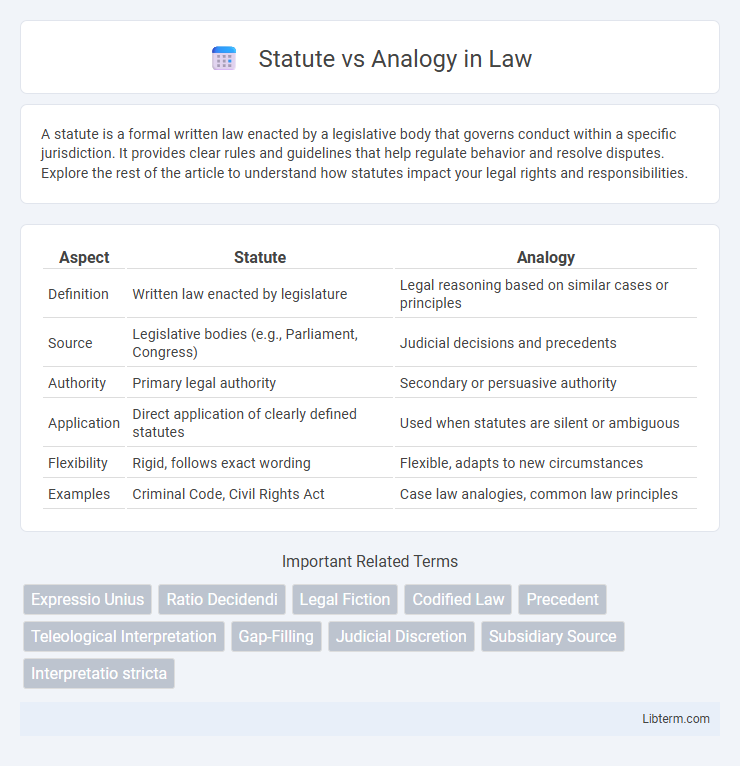A statute is a formal written law enacted by a legislative body that governs conduct within a specific jurisdiction. It provides clear rules and guidelines that help regulate behavior and resolve disputes. Explore the rest of the article to understand how statutes impact your legal rights and responsibilities.
Table of Comparison
| Aspect | Statute | Analogy |
|---|---|---|
| Definition | Written law enacted by legislature | Legal reasoning based on similar cases or principles |
| Source | Legislative bodies (e.g., Parliament, Congress) | Judicial decisions and precedents |
| Authority | Primary legal authority | Secondary or persuasive authority |
| Application | Direct application of clearly defined statutes | Used when statutes are silent or ambiguous |
| Flexibility | Rigid, follows exact wording | Flexible, adapts to new circumstances |
| Examples | Criminal Code, Civil Rights Act | Case law analogies, common law principles |
Definition of Statute
A statute is a written law enacted by a legislative body that governs conduct within a jurisdiction, providing clear rules and regulations. Unlike analogy, which derives legal principles by comparing similar cases or situations, a statute offers explicit, codified directives that courts and individuals must follow. Statutes serve as authoritative legal sources, ensuring consistency and predictability in the application of law.
Definition of Analogy
Analogy is a legal reasoning method that involves drawing a comparison between two similar cases or situations to apply the same legal principles when no specific statute exists. It helps fill gaps in legislation by interpreting laws in a way that is consistent with prior judicial decisions or legal concepts. Unlike statutes, which are explicit written laws enacted by legislative bodies, analogy relies on the identification of fundamental similarities to guide judicial outcomes.
Key Differences Between Statute and Analogy
Statutes are formal written laws enacted by legislatures that provide clear, codified rules applicable to specific situations, while analogies involve reasoning by comparing similar cases or principles to fill gaps where no statute exists. Statutes offer definitive legal authority and precise directives, whereas analogies rely on interpretative reasoning and judicial discretion to apply existing legal concepts to new or unique scenarios. The key difference lies in statutes being direct legal mandates, whereas analogies serve as persuasive tools for legal interpretation and decision-making.
Historical Development of Statute and Analogy
Statutes originated as formal written laws enacted by legislative bodies to provide clear, organized legal rules, evolving from customary practices and royal decrees in early societies. Analogy developed as a judicial tool to apply existing laws to new or unforeseen cases lacking explicit statutory provisions, thereby filling legal gaps based on principles of similarity and reasoning. The historical growth of statutes limited reliance on analogy by offering precise regulations, yet analogy remains essential for interpreting statutes and addressing cases beyond statutory scope.
Role of Statute in Modern Legal Systems
Statutes serve as primary sources of law, providing clear, codified rules enacted by legislatures that govern specific areas of society and replace or clarify common law principles. Their role in modern legal systems ensures consistency, predictability, and democratic legitimacy by reflecting the will of elected representatives. Unlike analogies drawn from previous cases, statutes offer explicit legal directives that courts must apply, reducing ambiguity and enhancing legal certainty.
Impact of Analogy on Legal Reasoning
Analogy significantly influences legal reasoning by extending existing statutes to novel situations, enabling courts to interpret laws flexibly and close legislative gaps. It aids judges in drawing parallels between cases, fostering consistency while adapting to evolving social contexts. This dynamic application enhances judicial decision-making without the need for explicit statutory provisions.
Statute: Advantages and Limitations
Statutes provide clear, codified laws that enhance legal certainty and predictability by offering precise guidance for judges and citizens. Their advantages include the ability to address specific issues comprehensively and enable democratic oversight through legislative processes. However, statutes can be inflexible, often failing to adapt quickly to new or unforeseen circumstances, which limits their effectiveness in dynamic or complex legal scenarios.
Analogy: Benefits and Drawbacks
Analogy in legal reasoning offers the benefit of flexibility, allowing courts to apply principles from established cases to new, unforeseen situations, fostering consistent and adaptable jurisprudence. It aids in filling legislative gaps by drawing parallels between similar facts or issues, enhancing fairness and predictability in decisions. However, reliance on analogy may introduce subjectivity, as interpretations vary, potentially leading to inconsistent verdicts and undermining legal certainty compared to strict statute-based rulings.
Case Studies: Statute vs Analogy in Practice
Case studies contrasting statute versus analogy reveal critical differences in legal interpretation and application. Statutory cases rely on explicit legislative language, as seen in landmark rulings like Marbury v. Madison, where written statutes dictated judicial decisions. Analogy-based cases, exemplified by Brown v. Board of Education, leverage precedent and reasoning from similar situations to address novel legal questions beyond statutory text.
Choosing Between Statute and Analogy in Legal Interpretation
Choosing between statute and analogy in legal interpretation hinges on the clarity and specificity of the statute in question. Courts prioritize statutory language when statutes explicitly address an issue, ensuring legal certainty and adherence to legislative intent. When statutes are ambiguous or silent, analogy aids in filling gaps by applying existing legal principles to similar cases, promoting consistency and fairness in judicial decisions.
Statute Infographic

 libterm.com
libterm.com